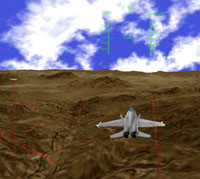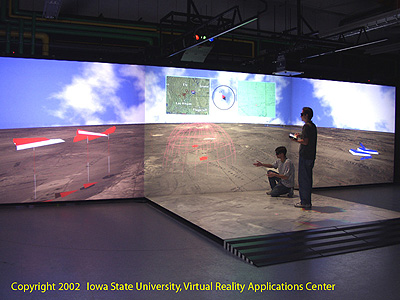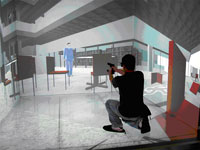
Immersive Battlespace Visualization
Under grants from the Air Force Research
Lab and the National Guard, researchers at the Virtual Reality Applications
Center (VRAC) at Iowa State University are using immersive visualization to
addresses the critical need for battlefield information to pierce the confusion
and haze of war. As our surveillance and intelligence capabilities continue
to increase, the issues of discrimination, selection and dissemination of
information become paramount. The key question is: How to deliver the right
information to the right people at the right time? The VRAC team is looking
to provide insight into these issues in the context of an integrated, immersive
environment for battlespace visualization. Working with command and control
experts from the 133rd ACS squadron in Fort Dodge, Iowa, the team has developed
a virtual Joint Battlespace for collecting, displaying and interacting with
battlespace data in an intuitive and easily understandable format. Battlespace
managers and weapons directors are able to easily navigate within the environment,
reach for data, and relay information with a gesture. By removing the seams
between the data and the user, the virtual environment becomes an extension
of the battlespace manager's senses. This allows the user to concentrate on
the situation awareness problem and not the interface to it.
People:
Carolina Cruz-Neira, Adrian Sannier, James Oliver, Bryan Walter, Jared Knutzon,
Justin Hare, Liangshou Wu, Karen Peretti

Biomolecular visualization
To help better understand RNA-protein
interactions during the course of E. coli 30S ribosomal subunit assembly,
a team of VRAC researchers are working with Dr. Gloria Culver and her team
of biochemists to immersively visualize the structure and movement of the
30-S subunit of the human ribosome. These studies involve developing methods
for viewing 3-D structures in the C6 virtual reality cave and then incorporating
movement within these molecules. We hope that these applications will be of
use to any investigator interested in dynamics and complicated structures.
People:
Gloria Culver, Kristi Holmes, Darrin Lemmer, Adrian Sannier, James Oliver,
Ronald Sidharta, Jason Schneekloth, Tom Batkiewitz
A Multi-Purpose First Person Environment
VRAC researchers have developed
a multi-user, collaborative environment that can be used as a research platform
for studies in the psychology of video games, as well as high-fidelity training
for homeland security and forensics applications.
The application was originally developed to investigate the linkage between
aggressive behavior and increased realism in video games. Professor Craig
Anderson of the ISU Psychology Department has built an international reputation
studying the link between violent media and aggressive behavior. Working with
Dr. Anderson and his team, ISU researchers developed a highly immersive, realistic
version of a “first-person shooter” environment based on an accurate
model of the ISU Design Center. Multiple participants can interact with one
another in this environment, use weapon-based controllers and use their bodies
to duck behind objects and move about in the environment. In the fall, researchers
will compare the aggressive responses of participants in this highly realistic
simulation, with similar responses from players of non-violent, non-immersive
desktop based games.
This same research platform is also being used to explore applications to
Homeland Security and forensics training. Multiple users, in distributed locations
can meet in the simulated environment and together experience specially designed
training scenarios that illustrate potentially dangerous situations in a realistic,
but safe, environment. This work in progress has been demonstrated for the
National Sherrifs Association and Iowa Homeland Security Advisor Ellen Gordon.
Immersive training can be used to build the experience of first-responder
teams to potential threats without placing them in any danger.
People:
Adrian Sannier, James Oliver, Ronald Sidharta, Jason Schneekloth, Tom Batkiewitz,
Chad Austin



 |
|||||||||||